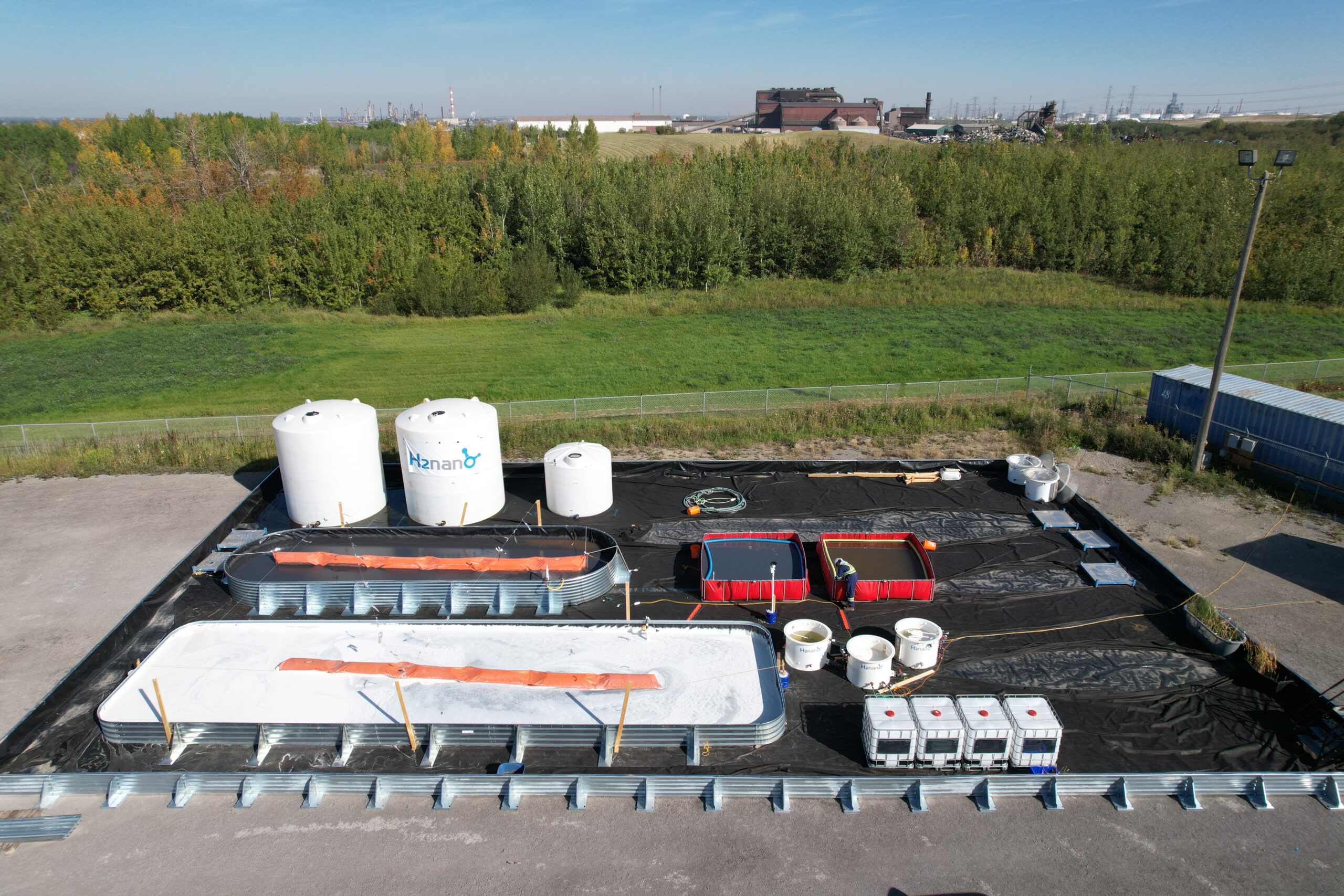With support from the Ontario Water Consortium’s Water Industry Growth Program, H2nanO is leading the way with its SolarPass technology, offering a groundbreaking solution for mining wastewater treatment.
Mining operations use water for everything from extracting ore to transporting slurry. In the process, that water gets loaded with contaminants that must be removed before it can be released or reused. But if you take the right approach to treatment, you don’t just end up with cleaner water. You can also recover valuable metals and minerals that can be used to create all kinds of things — from steel to solar panels.
H2nanO believes their SolarPass technology offers a simple, affordable way to do that. The Kitchener company has developed a solar-activated nano-catalyst that can treat polluted water right on site.
Their buoyant ceramic beads are designed to float on the surface of a holding pond. When sunlight hits them, it triggers a catalytic response that breaks down H2O into hydroxyl radicals — powerful oxidants that attacks contaminants. It’s a beautifully simple procedure, with no electricity, no chemical inputs and no expensive infrastructure required.
“You can think about each of these beads as a little chemical factory that’s converting light energy directly into chemicals for oxidation in the water itself,” explains Zac Young, COO and co-founder of H2nanO.
With help from OWC, the company has already proved that SolarPass can successfully treat the contaminants in petroleum process water. Now, with funding from OWC’s Water Industry Growth (WIG) program — which supports the development of innovative water technologies — H2nanO is testing whether their beads can do the same in the mining sector.
Moving into metals
To start, H2nanO is focussing on manganese, a metal often found at elevated concentrations in mining process water. The basic approach remains the same: oxidize the contaminants you’re trying to remove. But there are some big differences.
The toxic organics found in petroleum process water are large, multi-ringed molecules that are not easily biodegraded. Oxidizing them breaks them into smaller, more soluble, nontoxic components.
In contrast, manganese is a single atom. Here, the goal of oxidizing isn’t to break it down. Instead, oxidizing manganese turns it into a compound that precipitates out, making it easy to separate and remove.
Venturing into this new arena involved lots of learning for H2nanO’s R&D team. They needed to characterize the oxidative pathways for treating a spectrum of metals in the wastewater. They needed to validate the solution. And they needed to compare its effectiveness to existing options.
They also needed to figure out how to recharge the SolarPass beads. As H2nanO has discovered, when you oxidize manganese, it tends to precipitate onto the beads. That buildup occupies the catalytic surface and adds weight, so the beads need a periodic regeneration.
However, as the team works on overcoming those hurdles, they’re making happy discoveries as well. For example, it turns out that when manganese precipitates, it can pull out other dissolved metals with it and simultaneously drive even more oxidation. Now, H2nanO is examining those mechanisms so they can use them to full advantage.
Catalyzing commercial success
This novel application for SolarPass is already attracting plenty of attention within the mining industry. One interested company stepped up to fund some of the initial characterizations and trials in H2nanO’s Kitchener facility.
But WIG funding was also hugely important, Young says, because it allowed them to build back-end capacity and validate aspects of their technology in metals treatment that H2nanO needed to develop into their core IP. “The WIG program helped us take more of a deep dive into how the technology is working with dissolved metals and solve some fundamental questions,” he explains.
Lots of details still need to be worked out on the road to commercial readiness, both at the bench scale and the field scale. But Young is pleased with the success they’ve achieved to date thanks to the WIG program. “We’ve made good progress,” he says. “We proved exciting results while discovering where we have opportunities to hone our metals treatment and valorization.”
In the final few months of the project, they’ll extend their testing to other metals, expanding potential applications for SolarPass, as well as evaluating an evaporation enhancing variation of SolarPass for application in solution mining, such as for lithium and potash.
Young sees the project as a stepping stone to bigger success. Publishing the results in academic papers and presenting them at conferences will give their solution credibility when H2nanO begins marketing SolarPass to potential mining customers. And in the near future, they’re planning to launch a larger-scale, international trial with their current partner.
It all points to a bright future for the expanding company, which now boasts 16 employees and an office in Alberta. That growth is exciting. But for Young, the big motivation is making the world’s resources and energy more sustainable by tackling hard-to-treat wastewater and recovering critical minerals from it. “That’s the part we like most about working on these problems,” he says.
WIG supports industry innovations that accelerate growth, create jobs and strengthen Ontario’s water sector. For more information, click here.


